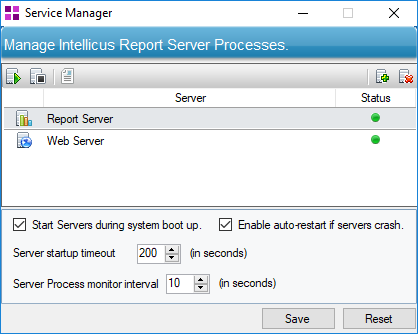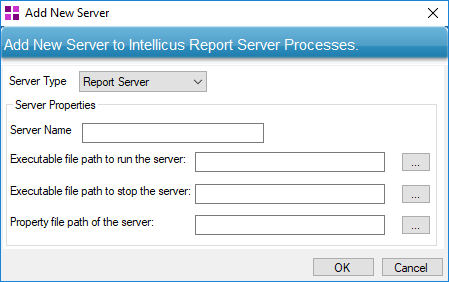Intellicus Reporting Service
Windows Service Manager is a tool that helps simplify common tasks like stop or start some service, disable the service, delay its start up or resume or pause the Windows Service. Intellicus Reporting Service is a Windows NT Service. It launches Report Server, Web Server and Load Balancers in SYSTEM account. Processes that run in SYSTEM account continue to run even after the user logs off.
Figure 1: Intellicus Reporting Service
The purpose of launching these processes by a service is that user does not need to login to start the Intellicus processes. This service starts automatically when system boots up, which in turn starts Intellicus servers.
Servers
Intellicus Service Manager manages the following server processes:
Report Server: This server serves reporting and internal repository services to clients.
Web Server: Provides a web-based interface to users, takes requests from users and sends to report server. Receives responses from report server and sends to users.
Load Balancer Server: To achieve extended scalability and high availability of Intellicus BI infrastructure, you can install Intellicus report servers on multiple machines to form a cluster and configure load balancing and fail-over.
In heavy load environment, multiple report servers are deployed. Load Balancer Server (in a clustered environment) receives user requests and distributes it to different report servers.
Intellicus Service Manager
Intellicus’ Service Manager is a Windows user interface to view and manage Intellicus Server processes.
Opening Service Manager
From the Start Menu, go to Intellicus > Service Manager option.
Figure 2: Service Manager dialog
Service Manager lists all the Intellicus services that it manages along with their latest status (like started or stopped). When you select a server, its properties are displayed below the list.
Tool buttons
: To add a server.
: To delete a server. When you delete a server, that server is stopped if it is running, and then it is removed from the manager list.
: To start the selected (highlighted) server.
: To stop the selected (highlighted) server. Highlight the server on which you want to act. You can highlight multiple servers as well. For example, highlight Report Server and Web Server (shift+click) and click button to stop both the servers.
: To view logs of the selected server.
Note: A server when it is in the process of starting up cannot be deleted or stopped. You cannot take an action on a server that is in the process of stopping.
Action buttons
Save: You need to click the Save button to save changes made on Add New Server dialog and Service Manager dialog (like any configuration or global setting change).
Reset: Click Reset button to abandon the changes made on Add New Server dialog and Service Manager
Adding a server
Note: When you add a server, make sure the server is in stopped state.
When you try adding a server that is in running state, service does not know that it is already in running state. When service tries to start such a server, the service may find configured port as “bound” and may result in an error.
To add a server, click button on Service Manager. The Add New Server dialog opens.
Figure 3: Add New Server dialog
You need to provide the following information while adding a server:
Server Type: Depending on the type of server you are adding, select from Report Server, Web Server or LoadBalancer Server.
Server Name: A unique name for Service Manager to identify this server.
The name must not contain characters other than alphabets, numerals, period, dash, @, space and underscore.
You need to specify file name including path of:
Executable file path to run the server: File that the service will execute to startup the server. Example:
D:Program FilesIntellicusReportEnginebinrun.bat
Executable file path to stop the server: File that the service will execute to stop (shutdown) the server.
Example:
D:Program FilesIntellicusReportEnginebinshutdown.bat
Property file path of the server: Server will need this file to get the values like port at which the server should run, path where log file should be created log file path, etc.
Example:
D:Program FilesIntellicusReportEngineConfig ReportEngine.properties
Specify the information and click OK. The Add New Server dialog will be closed and newly added server will be listed on the Service Manager dialog.
A server can be started only after it is saved. To save the changes, click Save button on Service Manager dialog.
Server properties
The below mentioned properties are common for all the servers.
Figure 4: Server Properties
Start Servers during system boot up: Check this to start all the servers when system boots up. If you keep it unchecked, you can manually start individual services from Service Manager window.
Enable auto-restart if servers crash: Check this to auto-restart a server if Intellicus Service finds it crashed. Intellicus Manager will consider a server as crashed if it is not stopped from within Intellicus Service Manager.
Server startup timeout: When a server is started, Intellicus service keeps on pinging the server to know if it has started. Server startup timeout is the time in seconds for which the service will keep on pinging and wait for server to respond. If server fails to respond within this time, it stops pinging and logs error in the Event Viewer. Specify a value between 0 and 7200 (seconds).
Server Process monitor interval: This is the time (in seconds) after which Intellicus Service will check if server is running or not. Value can be between 10 and 7200 (seconds).








